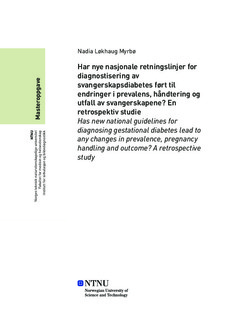| dc.contributor.advisor | Balstad, Elisabeth Magnussen Stridsklev, Solhild | |
| dc.contributor.author | Myrbø, Nadia Løkhaug | |
| dc.date.accessioned | 2019-09-28T14:00:28Z | |
| dc.date.available | 2019-09-28T14:00:28Z | |
| dc.date.issued | 2019 | |
| dc.identifier.uri | http://hdl.handle.net/11250/2619231 | |
| dc.description.abstract | | |
| dc.description.abstract | Introduction: In 2017 the Norwegian Health authorities implemented new guidelines and reference ranges for diagnosing gestational diabetes. The high prevalence of diabetes globally and the increased occurrence in women of gestational age, generated new research on the association between high blood glucose levels and pregnancy outcome. The aim of this study is to explore whether these new guidelines have led to any changes in the prevalence of gestational diabetes, pregnancy handling and outcome in women diagnosed with gestational diabetes.
Method: Pregnancies complicated with gestational diabetes at St. Olavs Hospital in 2016 and 2018 where included. Variables such as gestational age, induction rate, mode of delivery and birth weight were recorded. Seven women were excluded due to twin-pregnancies, two because their PID-number could not be searched for in Doculive and one due to pre gestational diabetes type 1. That left 261 women for inclusion, 149 delivered in 2016 and 112 delivered in 2018.
Results: There are minor changes in the pregnancy outcomes from 2016 to 2018 after implementation of new guidelines. Some important findings are that a higher proportion of these women gave a vaginal birth in 2018 compared to 2016 (69.6 % vs. 52.3 % p<0.05). More deliveries occured between week 37+0 and 38+6 in 2018 (46.4 % vs. 26.8 % p<0.05) and less women gave birth in or after gestational week 41 (5.4 % vs. 13.4 % p<0.05) in 2018. The prevalence of gestational diabetes declined from 3.9 % in 2016 to 3.2 % in 2018. There was an increase in consultations with endocrinologists (mean: 1.66 more consultations per woman). Mean birthweight did not change significantly from 2016 to 2018 (3623 grams vs. 3559 grams).
Conclusion: Our findings suggest that the new guidelines did not lead to any major changes in pregnancy handling or outcomes. There was no significant increase in the prevalence of gestational diabetes after implementation of new guidelines. | |
| dc.language | nob | |
| dc.publisher | NTNU | |
| dc.title | Har nye nasjonale retningslinjer for diagnostisering av svangerskapsdiabetes ført til endringer i prevalens, håndtering og utfall av svangerskapene? En retrospektiv studie | |
| dc.type | Master thesis | |
